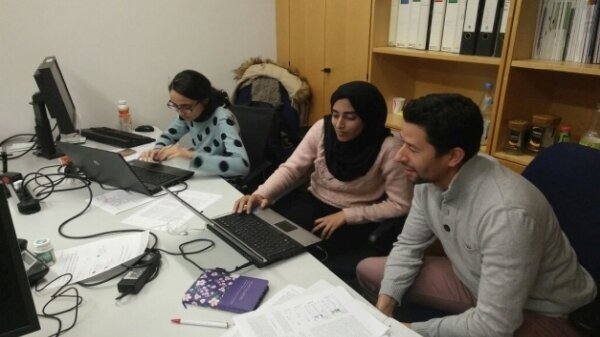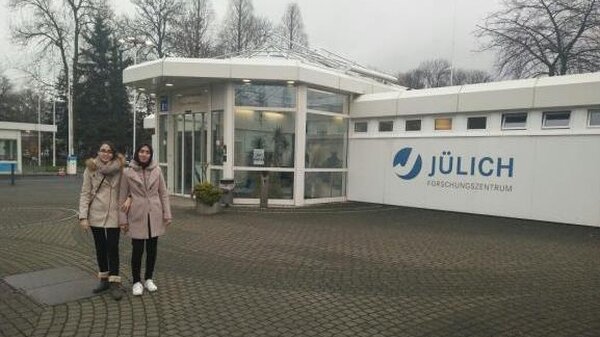Snowballing Scholarly Success: AGYA Members Bring Arab-Arab-German Cooperation in Nanotechnology to Flourish
Snowballing Scholarly Success: AGYA Members bring Arab-Arab-German Cooperation in Nanotechnology to Flourish
As a platform for connecting outstanding early-career scholars from the Arab world and Germany, AGYA strives to facilitate durable, productive partnerships between individual scholars, research institutions and key societal stakeholders. AGYA member Samir Lounis and now-alumna Lalla Btissam Drissi’s collaborative research on cutting-edge nanotechnology is an excellent example of bilateral research cooperation between two AGYA members that continues to grow into additional project ideas, boost members’ careers and foster new networks.
Researching Low-dimensional Nanomaterials: Playing Legos with Atoms
Understanding materials at the nanoscale is essential for developing future technologies. At its core, nanotech research entails altering the very building blocks of matter – atoms, molecules and groups of molecules – to discover enhanced physical properties for engineering new materials and products. One nanometre equals one billionth of a metre. At that scale, materials demonstrate unique physical, chemical and biological characteristics at different dimensions (0D, 1D, 2D and 3D). At lower dimensions, the greater surface area of nanomaterials affects their reactivity, posing opportunities for a wide range of electronic, magnetic, optical and biomedical applications. In 2016, two AGYA members – Lalla Btissam Drissi (Department of Physics at Mohammed V University, Rabat, Morocco) and Samir Lounis (Peter Grünberg Institute at the Forschungszentrum Jülich, Germany) – joined forces to launch an interdisciplinary ‘Moroccan-German Partnership on Modelling and Simulations of Physical Properties of Nanomaterials’.
Building Bilateral Nanotech Research Cooperation Between Morocco and Germany
In the framework of an AGYA Tandem Project, a format involving bilateral research and exchange between one Arab and one German AGYA member across disciplinary boundaries, Drissi and Lounis combined their respective interests in 2D nanomaterials and magnetism at the intersection of physics, chemistry and engineering. They visited each other’s institutes, where in addition to giving seminars and lectures, the idea of sustainable joint projects were born. As part of their AGYA collaboration, one of Drissi’s Moroccan PhD students, Siham Sadki, spent three months in Jülich, where she learned the basics of a key software developed by the centre and used it to run calculations for the first Rabat-Jülich research project investigating the impact of quantum fluctuations on the magnetic stability of single atoms deposited on graphene. ‘In the framework of AGYA, Samir Lounis and I were able to establish sustainable scientific collaboration between our respective institutes in Morocco and Germany in the highly competitive field of nanomaterial research. This knowledge exchange has significantly boosted our research capacities in Rabat’, says Drissi. For Lounis, meanwhile, the AGYA collaboration provided ‘an immersive introduction into the scientific landscape for nanomaterial research in Morocco and increased the international outreach of our work in Jülich’.
Expanding the Moroccan-German Nanomaterial Research Network Beyond Rabat and Jülich
In 2017, Drissi and Lounis initiated another AGYA Tandem Project to further strengthen and expand their Moroccan-German partnership from a bilateral to a multilateral research network. With the addition of collaborators from the ‘Physikalische Institut’ at the University of Heidelberg, the expanded network combined their research specialties – mechanical and optical in Rabat, electronic and magnetic in Jülich, and atomic/quantum physics in Heidelberg – to further advance research on the possible manipulation of physical properties of low-dimensional nanomaterials. In two collaborative projects, the partners used halogens to demonstrate the possibility of engineering the optoelectronic responses of two-dimensional materials for far-reaching potential applications, and studied the spin-excitations of nanomagnets in relation to their potential for storing information as magnetic bits. In addition to producing peer-reviewed publications, the AGYA project allowed two postdocs and one PhD student from Germany to give lectures and hands-on workshops on different topics, theoretical techniques and methodologies in Rabat, and three senior professors – one from Morocco and two from Germany – to deliver talks and exchange ideas.
Branching Out Further to Include Algeria and Tunisia in North-South-South Cooperation
In a third AGYA Tandem Project in 2018/19, Drissi and Lounis expanded their unique and successful Moroccan-German network even further to include more teams from diverse research institutes in Germany and Morocco, as well as two additional countries in the Maghreb region: Algeria and Tunisia. This Tandem Project, in combination with other external funding, facilitated knowledge transfer, cross-disciplinary collaboration and research exchange visits for PhD students, post-docs, as well as junior and senior professors from four research institutes or universities in Germany (in Berlin, Heidelberg, Jena and Jülich), five in Morocco (in Agadir, Béni Mellal, Fès-Meknès and Rabat), four in Algeria (in Fesdis, Setif, Sidi Bel Abbès and Tizi-Ouzou) and one in Tunisia (Tunis). The topics researched spanned a rich spectrum of quantum matter at low dimensions, such as hybrid and magnetic nanostructure compounds, as well as a broad range of phenomena involving topological phases, spin-relaxation and spin dynamics.
Snowballing Scholarly Success
To date, Drissi and Lounis’ scholarly successes have snowballed significantly. Their research cooperation has yielded over 15 scientific publications, numerous personal professional milestones and incredible contributions to the interdisciplinary field of nanomaterial research. In terms of boosting their careers, Drissi’s successes have included earning a 200,000 Euro research grant from the ‘Académie Hassan II des Sciences et Techniques-Morocco’, which features Lounis as a German partner. In 2019, she received the prestigious Georg Forster Research Fellowship from the Alexander von Humboldt Foundation, enabling her to conduct further research visits in Germany, both in Jülich and Jena, for 18 months. She also now coordinates a networking mobility fund for 2D material research that spans 10 African countries, sponsored by the Abdus Salam International Centre for Theoretical Physics in Trieste, Italy. Lounis serves as a European partner and consultant for this network, while additional AGYA colleagues, Olfa Messaoud and Faycal Djeffal, have joined it as members. The trajectory of Drissi and Lounis’ collaboration over the years aptly illustrates the invaluable opportunities AGYA membership offers early-career researchers from the Arab world and Germany.


